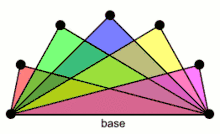Book (graph theory)
In graph theory, a book graph (often written ) may be any of several kinds of graph formed by multiple cycles sharing an edge.

Variations
One kind, which may be called a quadrilateral book, consists of p quadrilaterals sharing a common edge (known as the "spine" or "base" of the book). That is, it is a Cartesian product of a star and a single edge.[1][2] The 7-page book graph of this type provides an example of a graph with no harmonious labeling.[2]
A second type, which might be called a triangular book, is the complete tripartite graph K1,1,p. It is a graph consisting of triangles sharing a common edge.[3] A book of this type is a split graph. This graph has also been called a .[4] Triangular books form one of the key building blocks of line perfect graphs.[5]
The term "book-graph" has been employed for other uses. Barioli[6] used it to mean a graph composed of a number of arbitrary subgraphs having two vertices in common. (Barioli did not write for his book-graph.)
Within larger graphs
Given a graph , one may write for the largest book (of the kind being considered) contained within .
Theorems on books
Denote the Ramsey number of two triangular books by This is the smallest number such that for every -vertex graph, either the graph itself contains as a subgraph, or its complement graph contains as a subgraph.
- If , then .[7]
- There exists a constant such that whenever .
- If , and is large, the Ramsey number is given by .
- Let be a constant, and . Then every graph on vertices and edges contains a (triangular) .[8]
References
- Weisstein, Eric W. "Book Graph". MathWorld.
- Gallian, Joseph A. (1998). "A dynamic survey of graph labeling". Electronic Journal of Combinatorics. 5: Dynamic Survey 6. MR 1668059.
- Lingsheng Shi; Zhipeng Song (2007). "Upper bounds on the spectral radius of book-free and/or K2,l-free graphs". Linear Algebra and its Applications. 420: 526–9. doi:10.1016/j.laa.2006.08.007.
- Erdős, Paul (1963). "On the structure of linear graphs". Israel Journal of Mathematics. 1: 156–160. doi:10.1007/BF02759702.
- Maffray, Frédéric (1992). "Kernels in perfect line-graphs". Journal of Combinatorial Theory. Series B. 55 (1): 1–8. doi:10.1016/0095-8956(92)90028-V. MR 1159851..
- Barioli, Francesco (1998). "Completely positive matrices with a book-graph". Linear Algebra and its Applications. 277: 11–31. doi:10.1016/S0024-3795(97)10070-2.
- Rousseau, C. C.; Sheehan, J. (1978). "On Ramsey numbers for books". Journal of Graph Theory. 2 (1): 77–87. doi:10.1002/jgt.3190020110. MR 0486186.
- Erdős, P. (1962). "On a theorem of Rademacher-Turán". Illinois Journal of Mathematics. 6: 122–7. doi:10.1215/ijm/1255631811.